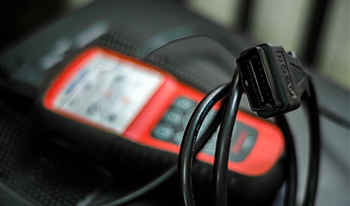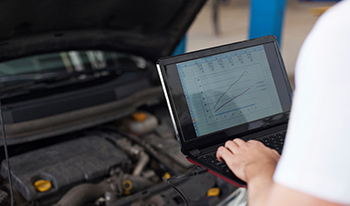“The fact is, the most expensive tool may not be the best tool for you. It depends on what vehicles you work on and what you want out of the tool.”
– Dwayne Myers, Dynamic Automotive, Frederick, MD
If a 1996 or newer vehicle with OBD II rolls into your shop with a Check Engine light on (aka the malfunction indicator lamp or MIL), it is probably because the power control module (PCM) is receiving data indicating that all is not well. Whether the light comes on intermittently or remains steady, the vehicle cannot pass the state emissions test until the technician determines the source of the problem and resolves the issue. On such occasions, a tech normally reaches for a scan tool for diagnostic help.
An automotive scan tool is essential for performing advanced on-board diagnostics. It enables technicians to access a vehicle’s OBD system in order to not only read the diagnostic trouble codes (DTCs) – which a simple code reader or scanner can also do – but, more importantly, can also perform a variety of system self-checks to determine the source of the trouble. This may include, but is not limited to, checking the operation of the fuel pump, fuel injectors, idle speed control motor or solenoid, EGR solenoid, A/C compressor clutch, cooling fans, EVAP purge controls, cylinder balance testing, misfire graphing and much more.
As cars have become more and more sophisticated, so have the scan tools to diagnose and repair their complex on-board electronics. Many manufacturers offer a variety of models at various price points with a broad range of features to suit the level of functionality desired and the mix of makes and models that a shop services. It is not unusual, therefore, for a shop to own several scan tools with different diagnostic capabilities. If a shop works on a single vehicle make, it has the option to purchase a dealer-specific tool. Those are usually expensive, but the need for factory-based scan tools is becoming increasingly necessary for most popular car lines because programming and network issues are starting to require them. One hopes aftermarket tool manufacturers will keep up with this growing need.
While a do-it-yourselfer (DIYer) can function with a simpler tool that offers fewer functions, a scan tool for professional technicians needs to incorporate many more features including the important bi-directional capability or two-way communication. Bi-directional capability allows a technician to “talk back” to the system. In other words, one can not only learn what is going on at the other end, but also can activate certain functions at the same time, such as turn on the ABS motor in the car, pop the trunk open electronically or turn on the headlights.
 Return On Investment
Return On Investment
The price of a top quality scan tool runs high, but it is usually well worth the cost in the long run.
“Cost is always a factor, but to me it is never the first,” said Dwayne Myers of Dynamic Automotive in Frederick, MD. “The fact is, the most expensive tool may not be the best tool for you. It depends on what vehicles you work on and what you want out of the tool. You will need to invest money in purchasing a quality scan tool, but you must also invest time in finding the tool that is best for you.”
Features To Look For
Some of the features that you may want to look into before you invest in a scan tool, are: speed; diagnostic capability; full scan functionality; breadth of vehicle coverage with OE-level access to Asian, European and domestic applications; bi-directional capability; software updatability; and module coding and re-flashing capability with vehicle-specific information and VIN number.
 Look for a model that is fast – one that is able to decode a VIN and communicate with all modules and report DTCs in a couple of seconds. Also, be sure it is accurate and easy-to-use with subscription-based software updates that can be downloaded quickly from the Internet and one that can be connected via Bluetooth or USB with ultra-fast, real-time streaming live data with the ability to graph different functions.
Look for a model that is fast – one that is able to decode a VIN and communicate with all modules and report DTCs in a couple of seconds. Also, be sure it is accurate and easy-to-use with subscription-based software updates that can be downloaded quickly from the Internet and one that can be connected via Bluetooth or USB with ultra-fast, real-time streaming live data with the ability to graph different functions.
Scan tools can be desktop-, laptop-, tablet- or smartphone-based. Most scan tools use the PC or Android system, but there are also those that run on the iOS operating system. Some manufacturers offer a lifetime warranty on the hardware.
Scan tool tablets are usually drop-tested and some models are also designed to be water-proof. Depending on the model you select, it may come with a high-resolution IPS touch screen, a high-resolution camera with still and video capabilities and reduced screen-to-screen wait times.
Some scan tools feature customer remote diagnostic capability. This means that a technician can analyze a customer’s vehicle data remotely – miles away from the shop. A good scan tool may also alert a technician to web-based repair data via a website service or a technician forum, or even perform a Google search within a diagnostic session.
 Whatever make or model you ultimately choose, make sure that the software on your scan tool is updated – refresh rates on data is very important.
Whatever make or model you ultimately choose, make sure that the software on your scan tool is updated – refresh rates on data is very important.
“If you want to be considered one of the top shops in your area,” Myers concluded, “you must have the appropriate tools to do the job. For accurate diagnostics, for instance, you must have good information and to get this information, you need scan tools. I say that in the plural because no two tools are exactly the same and, I believe, you need more than one brand to get ‘good’ information. Integrity of the data is critical for a proper diagnosis. Nothing is worse than getting bad information; it costs you money, time and your reputation.”







